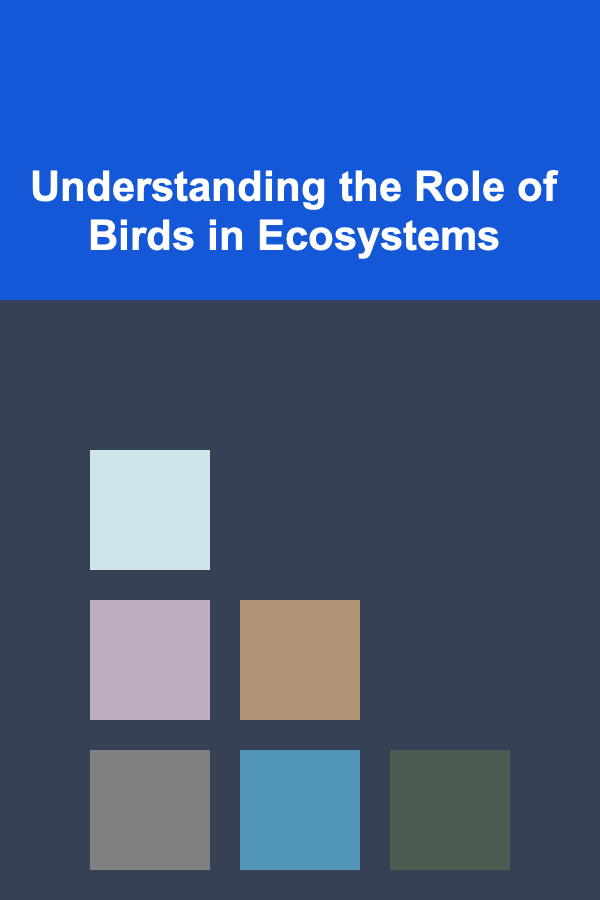
Understanding the Role of Birds in Ecosystems
ebook include PDF & Audio bundle (Micro Guide)
$12.99$8.99
Limited Time Offer! Order within the next:

Introduction: Avian Architects of the Natural World
Birds, with their dazzling diversity in form, function, and behavior, are far more than just beautiful creatures gracing our skies and gardens. They are integral components of ecosystems worldwide, playing a multitude of critical roles that directly influence the health, stability, and resilience of the natural world. Understanding the complex interactions of birds within these ecosystems is crucial for effective conservation efforts and for appreciating the intricate web of life that sustains us all.
This article delves deep into the multifaceted roles of birds in ecosystems, exploring their contributions to pollination, seed dispersal, pest control, nutrient cycling, and their position within food webs. We will examine specific examples of bird-ecosystem interactions and discuss the consequences of bird decline on ecological processes. Ultimately, this comprehensive overview aims to provide a deeper understanding of the importance of birds and the urgent need for their protection.
Pollination: Flying Messengers of Plant Reproduction
While bees often take center stage in discussions about pollination, birds play a significant and often overlooked role in the reproduction of numerous plant species, particularly in tropical and subtropical regions. Birds that act as pollinators, often referred to as ornithophilous birds, have evolved specific adaptations to facilitate the transfer of pollen from flower to flower.
Key Adaptations for Bird Pollination:
- Brush-tipped tongues: Many nectar-feeding birds possess specialized tongues with brush-like structures at the tip, which effectively collect pollen grains from the anthers of flowers.
- Tubular bills: Long, slender bills allow birds to access nectar deep within tubular flowers that are inaccessible to other pollinators.
- Bright coloration and scentless flowers: Bird-pollinated flowers are often brightly colored (red, orange, yellow) to attract birds, which have excellent color vision. They tend to be scentless, as birds have a poor sense of smell compared to insects.
- Abundant, dilute nectar: Bird-pollinated flowers typically produce large quantities of nectar with a relatively low sugar concentration, catering to the high energy demands of birds.
Examples of Bird Pollinators:
- Hummingbirds: Found primarily in the Americas, hummingbirds are perhaps the most well-known bird pollinators. Their rapid wingbeats allow them to hover in mid-air while feeding on nectar from flowers such as fuchsias, salvia, and trumpet vines. They are key pollinators in many neotropical ecosystems.
- Sunbirds: In Africa, Asia, and Australia, sunbirds fill a similar ecological niche to hummingbirds. They pollinate a wide variety of flowering plants, including proteas, aloes, and grevilleas.
- Honeyeaters: Native to Australia and surrounding islands, honeyeaters are a diverse group of birds that feed on nectar and pollen. They are important pollinators of eucalyptus trees and other Australian native plants.
- Lorikeets and Lories: These brightly colored parrots, also found in Australia and the Pacific, consume nectar and pollen in addition to fruits and seeds. They are crucial pollinators in rainforest ecosystems.
The relationship between bird pollinators and their host plants is often highly specialized, with co-evolution driving the development of unique adaptations in both species. For example, some flowers have evolved specific shapes or orientations to match the bill morphology of their primary bird pollinator. The loss of bird pollinators can have cascading effects on plant populations, potentially leading to reduced genetic diversity, decreased seed production, and even local extinctions.
Seed Dispersal: Avian Transporters of Plant Life
Seed dispersal, the movement of seeds away from the parent plant, is essential for plant survival and distribution. It allows plants to colonize new areas, avoid competition with their offspring, and escape from pathogens and herbivores concentrated around the parent plant. Birds are highly effective seed dispersers, contributing significantly to the regeneration and maintenance of plant communities across a wide range of ecosystems.
Mechanisms of Bird-Mediated Seed Dispersal:
- Endozoochory: This is the most common mechanism, involving birds consuming fruits and passing the seeds through their digestive system. The seeds are then deposited in new locations via the bird's droppings. The digestive process can often scarify the seed coat, promoting germination.
- Epizoochory: This occurs when seeds attach to a bird's feathers or feet and are transported to new locations. Seeds dispersed in this way are often sticky or have barbed hooks that facilitate attachment.
- Scatter Hoarding: Some birds, such as jays, nuthatches, and woodpeckers, cache seeds in the ground or in tree crevices for later consumption. Seeds that are forgotten or left uneaten can germinate and establish new plants.
Examples of Seed-Dispersing Birds:
- Toucans: These colorful birds, found in Central and South America, are important dispersers of large-seeded fruits in tropical rainforests. Their large bills allow them to access fruits that are inaccessible to smaller birds.
- Hornbills: Similar to toucans in their ecological role, hornbills are found in Africa and Asia. They disperse seeds of a variety of tree species, contributing to forest regeneration.
- Cotingas: Another group of tropical birds, cotingas are known for their specialized fruit-eating habits. They are important dispersers of seeds in the Amazon rainforest.
- Thrushes: Found worldwide, thrushes are generalist fruit eaters that disperse seeds of a wide range of plants, including berries and small fruits.
- Jays: Jays are well-known for their scatter-hoarding behavior, which plays a crucial role in the dispersal of acorns and other tree seeds. They can transport seeds over long distances, contributing to the spread of forests.
The effectiveness of birds as seed dispersers depends on several factors, including the size and type of fruit they consume, their foraging behavior, their movement patterns, and the survival rate of seeds after ingestion. The loss of bird seed dispersers can have significant consequences for plant communities, leading to reduced seed dispersal distances, decreased seedling recruitment, and shifts in plant species composition. In some cases, the absence of key bird dispersers can even lead to the local extinction of certain plant species.
Pest Control: Avian Guardians of Agriculture and Forests
Many bird species are natural predators of insects and other invertebrates, playing a vital role in controlling pest populations in agricultural fields, forests, and urban environments. By consuming large quantities of insects, birds help to prevent outbreaks that can damage crops, trees, and other valuable resources. This natural pest control service provided by birds is increasingly recognized as an important alternative to chemical pesticides, which can have harmful effects on the environment and human health.
Types of Insectivorous Birds:
- Aerial Insectivores: These birds, such as swallows, swifts, and nightjars, catch insects on the wing. They are particularly effective at controlling flying insect populations, such as mosquitoes, flies, and moths.
- Ground Foragers: Birds that forage on the ground, such as robins, starlings, and killdeer, consume insects, worms, and other invertebrates from the soil and leaf litter. They help to control populations of ground-dwelling pests, such as grubs, cutworms, and snails.
- Foliage Gleaners: These birds, such as warblers, vireos, and chickadees, search for insects on leaves and branches. They are effective at controlling populations of leaf-eating insects, such as caterpillars, aphids, and beetles.
- Bark Probers: Birds that probe the bark of trees for insects, such as woodpeckers and nuthatches, are important predators of wood-boring insects, such as bark beetles and wood wasps. They help to prevent damage to trees and timber.
Examples of Birds as Pest Controllers:
- Barn Owls: These nocturnal predators are highly effective at controlling rodent populations in agricultural areas. A single barn owl can consume thousands of rodents per year, significantly reducing crop damage.
- Bluebirds: Bluebirds are voracious insectivores, consuming large quantities of caterpillars, grasshoppers, and other insects. They are often used in integrated pest management programs to control insect pests in orchards and vineyards.
- Purple Martins: These colonial swallows are known for their ability to consume large quantities of mosquitoes and other flying insects. They are often encouraged to nest near human settlements to provide natural mosquito control.
- Woodpeckers: Woodpeckers play a critical role in controlling populations of bark beetles and other wood-boring insects that can damage forests. They excavate tunnels in trees to reach the insects, providing nesting cavities for other birds and wildlife in the process.
The effectiveness of birds as pest controllers can be enhanced by providing suitable habitat and nesting opportunities. This can be achieved through practices such as planting native trees and shrubs, creating brush piles, and installing nest boxes. Reducing the use of pesticides can also help to protect bird populations and promote natural pest control. Research has shown that the economic value of the pest control services provided by birds can be substantial, highlighting the importance of conserving bird populations for the benefit of agriculture and forestry.
Nutrient Cycling: Avian Engineers of Soil Fertility
Birds contribute to nutrient cycling in ecosystems through a variety of mechanisms, including the deposition of guano (bird droppings), the redistribution of seeds and fruits, and the decomposition of carcasses. These processes help to transfer nutrients from one location to another, enriching soils and supporting plant growth. In some ecosystems, birds play a particularly important role in transporting nutrients from marine environments to terrestrial environments, or from resource-rich areas to resource-poor areas.
Mechanisms of Bird-Mediated Nutrient Cycling:
- Guano Deposition: Seabirds, such as guano birds (e.g., cormorants, pelicans, gannets), accumulate large quantities of guano on nesting islands. Guano is rich in nitrogen, phosphorus, and potassium, and it serves as a valuable fertilizer for plants and algae. Guano deposits can significantly enhance the productivity of coastal ecosystems.
- Nutrient Redistribution through Seed and Fruit Dispersal: When birds disperse seeds and fruits, they transport nutrients from the parent plant to new locations. This can help to enrich soils in areas that are otherwise nutrient-poor.
- Carrion Decomposition: Vultures and other scavenging birds play a vital role in the decomposition of carcasses. By consuming dead animals, they help to recycle nutrients back into the ecosystem. They also prevent the spread of diseases by removing decaying organic matter.
- Soil Disturbance: Some birds, such as mound builders, construct large nests that disturb the soil. This disturbance can help to aerate the soil, increase water infiltration, and promote nutrient cycling.
Examples of Bird-Related Nutrient Cycling:
- Seabird Islands: Seabird colonies can create nutrient hotspots on islands and coastal areas. The guano deposited by seabirds supports a rich diversity of plant and animal life.
- Vulture Restaurants: In some regions, vulture restaurants are established to provide a safe and reliable food source for vultures. These feeding stations help to concentrate nutrients and prevent the spread of diseases.
- Forest Gaps Created by Treefall and Subsequently Visited by Birds: When a tree falls in a forest, it creates a gap in the canopy. Birds often visit these gaps to forage for insects and seeds, contributing to nutrient cycling and plant regeneration.
The role of birds in nutrient cycling is often underestimated, but it can be crucial for maintaining the health and productivity of ecosystems. The decline of bird populations can disrupt these nutrient cycling processes, leading to reduced soil fertility, decreased plant growth, and altered ecosystem function.
Food Web Dynamics: Avian Links in the Chain of Life
Birds occupy various trophic levels within food webs, acting as predators, prey, and scavengers. Their presence and abundance can have significant cascading effects on the populations of other organisms in the ecosystem. Understanding the role of birds in food web dynamics is essential for predicting the consequences of bird decline and for developing effective conservation strategies.
Trophic Roles of Birds:
- Predators: Many birds are predators, feeding on insects, fish, amphibians, reptiles, mammals, and even other birds. They help to regulate the populations of their prey and maintain the balance of the food web.
- Prey: Birds are also prey for a variety of predators, including raptors, snakes, foxes, and cats. They provide an important food source for these predators.
- Scavengers: Some birds, such as vultures and crows, are scavengers, feeding on carrion. They help to recycle nutrients and prevent the spread of diseases.
Examples of Bird-Mediated Food Web Interactions:
- Top-Down Control by Raptors: Raptors, such as hawks and owls, can exert top-down control on prey populations, such as rodents and rabbits. Their presence can help to prevent overgrazing and maintain plant diversity.
- Seed Predation by Finches: Finches and other seed-eating birds can influence plant populations by consuming seeds. Their feeding behavior can affect the distribution and abundance of different plant species.
- Insectivore Influence on Plant Health: Insectivorous birds help to maintain plant health by controlling populations of herbivorous insects. Their presence can reduce damage to plants and improve crop yields.
The removal of birds from an ecosystem can have profound consequences for food web dynamics. For example, the decline of raptor populations can lead to increased rodent populations, which can then damage crops and spread diseases. Similarly, the loss of insectivorous birds can lead to outbreaks of insect pests, which can defoliate forests and reduce agricultural productivity. Conservation efforts must therefore consider the role of birds in food webs and aim to maintain the integrity of these complex ecological relationships.
The Impact of Bird Decline: A Warning from the Skies
Globally, bird populations are facing unprecedented declines due to a variety of factors, including habitat loss, climate change, pollution, and invasive species. This decline has far-reaching consequences for ecosystem health and human well-being, highlighting the urgent need for effective conservation action. The loss of bird species can disrupt pollination, seed dispersal, pest control, nutrient cycling, and other vital ecological processes, leading to cascading effects throughout the ecosystem.
Causes of Bird Decline:
- Habitat Loss: Deforestation, urbanization, and agricultural expansion are destroying and fragmenting bird habitats, reducing their access to food, shelter, and nesting sites.
- Climate Change: Climate change is altering bird migration patterns, breeding seasons, and food availability, making it difficult for birds to adapt and survive.
- Pollution: Pesticides, heavy metals, and other pollutants can poison birds directly or indirectly through their food chain. Plastic pollution also poses a significant threat to seabirds.
- Invasive Species: Invasive species, such as rats, cats, and snakes, can prey on birds, compete with them for food, and destroy their nests.
- Hunting and Trapping: Unsustainable hunting and trapping practices can decimate bird populations, particularly in developing countries.
Consequences of Bird Decline:
- Reduced Pollination and Seed Dispersal: The loss of bird pollinators and seed dispersers can lead to reduced plant reproduction, decreased genetic diversity, and altered plant community composition.
- Increased Pest Outbreaks: The decline of insectivorous birds can result in outbreaks of insect pests, which can damage crops, forests, and urban landscapes.
- Disrupted Nutrient Cycling: The loss of birds that contribute to nutrient cycling can lead to reduced soil fertility, decreased plant growth, and altered ecosystem function.
- Impaired Ecosystem Resilience: The decline of bird populations can weaken the resilience of ecosystems to environmental stressors, making them more vulnerable to climate change, pollution, and other threats.
The plight of birds serves as a warning signal about the overall health of our planet. Protecting bird populations is not only essential for biodiversity conservation but also for maintaining the ecological services that sustain human well-being.
Conservation Strategies: Protecting Avian Architects for a Sustainable Future
Conserving bird populations and their ecological roles requires a multifaceted approach that addresses the underlying causes of bird decline. This includes protecting and restoring bird habitats, mitigating climate change, reducing pollution, controlling invasive species, and promoting sustainable land management practices.
Key Conservation Strategies:
- Habitat Protection and Restoration: Establishing protected areas, such as national parks and wildlife refuges, is crucial for conserving bird habitats. Restoring degraded habitats, such as forests and wetlands, can also provide valuable habitat for birds.
- Climate Change Mitigation: Reducing greenhouse gas emissions is essential for mitigating the impacts of climate change on bird populations. This can be achieved through transitioning to renewable energy sources, improving energy efficiency, and reducing deforestation.
- Pollution Reduction: Reducing the use of pesticides and other pollutants can protect birds from direct and indirect poisoning. Properly managing waste and preventing plastic pollution can also help to protect seabirds.
- Invasive Species Control: Controlling invasive species is crucial for protecting birds from predation, competition, and habitat destruction. This can involve trapping, poisoning, and other methods.
- Sustainable Land Management: Promoting sustainable land management practices in agriculture, forestry, and urban development can help to minimize the impact of human activities on bird populations.
- Community Engagement and Education: Engaging local communities in bird conservation efforts is essential for ensuring their long-term success. Educating the public about the importance of birds and the threats they face can also help to raise awareness and support for conservation.
By implementing these conservation strategies, we can help to protect bird populations and ensure that they continue to play their vital roles in ecosystems for generations to come. The future of our planet depends on our ability to conserve biodiversity and maintain the integrity of ecological processes.
Conclusion: A Symphony of Wings, A Call to Action
Birds are far more than just aesthetically pleasing creatures; they are essential components of ecosystems, playing crucial roles in pollination, seed dispersal, pest control, nutrient cycling, and food web dynamics. Their presence enriches our lives and sustains the natural world upon which we depend. The alarming decline in bird populations globally serves as a stark reminder of the threats facing biodiversity and the urgent need for conservation action. By understanding the intricate roles of birds in ecosystems and implementing effective conservation strategies, we can help to ensure a future where the symphony of wings continues to fill our skies and the benefits of healthy ecosystems are enjoyed by all.
We must act now to protect bird habitats, mitigate climate change, reduce pollution, control invasive species, and promote sustainable land management practices. Only through a concerted and collaborative effort can we safeguard the future of these avian architects and the ecosystems they help to create.
Reading More From Our Other Websites
- [Biking 101] Top 5 Gravel Biking Bikes for Speed and Comfort on Rough Terrain
- [Home Pet Care 101] How to Maintain Your Home While Dealing with Pet Shedding
- [Personal Care Tips 101] How to Apply Lip Gloss to Enhance Your Lip Shape
- [Personal Care Tips 101] How to Use a Facial Cleanser to Remove Pollution and Environmental Toxins
- [Personal Care Tips 101] How to Incorporate a Face Mask into Your Skincare Routine
- [Organization Tip 101] How to Use Vertical Space for Family Room Organization
- [Personal Care Tips 101] How to Condition Your Hair After a Haircut
- [Gardening 101] From Kitchen Scraps to Garden Gold: A Beginner's Guide to Home Composting
- [Organization Tip 101] What Are the Best Organizing Methods for Small Spaces?
- [Organization Tip 101] How to Organize Your Wine Collection at Home

How to Maintain Your Home's Flooring for Longevity
Read More
How to Make Money Online as a Grant Writer: 10 Actionable Ideas
Read More
How to Store and Display Art in a Small Home
Read More
Maximizing Savings with Rebates and Incentives: A Complete Guide
Read More
How to Become a Better Gamer: A Comprehensive Guide
Read More
10 Tips for Work Planning for Shift Workers
Read MoreOther Products

How to Maintain Your Home's Flooring for Longevity
Read More
How to Make Money Online as a Grant Writer: 10 Actionable Ideas
Read More
How to Store and Display Art in a Small Home
Read More
Maximizing Savings with Rebates and Incentives: A Complete Guide
Read More
How to Become a Better Gamer: A Comprehensive Guide
Read More